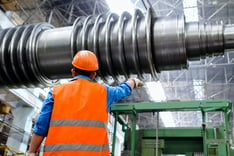 On November 22, the Occupational Safety and Health Administration (OSHA) issued a Safety and Health information Bulletin (SHIB) discussing “safety helmets” as evolved alternatives to traditional hard hats, and offering recommendations for situations where employers should switch. On December 11 the agency announced that it’s following its own advice and replacing its own employees/inspectors hard hats with safety helmets. The rest of this note discusses OSHA provisions for personal protective equipment (PPE) providing head protection, and the rationale and examples of the benefits of upgraded headgear.
On November 22, the Occupational Safety and Health Administration (OSHA) issued a Safety and Health information Bulletin (SHIB) discussing “safety helmets” as evolved alternatives to traditional hard hats, and offering recommendations for situations where employers should switch. On December 11 the agency announced that it’s following its own advice and replacing its own employees/inspectors hard hats with safety helmets. The rest of this note discusses OSHA provisions for personal protective equipment (PPE) providing head protection, and the rationale and examples of the benefits of upgraded headgear.
What hazards does head protection address?
OSHA’s PPE standards include requirements for “head protection” to be provided by “protective helmets” (29 CFR 1910.135 (general industry), 1926.100 (construction)). These standards are not self-explanatory; instead, they state that head protection must meet specified standards issued by the American National Standards Institute (ANSI), or be “at least as effective.” OSHA has updated its standards occasionally to reflect updates to ANSI’s standards.
Protective headgear provides protections against being hit by falling materials or being injured during a slip or fall, and can provide at least some electrical insulation. Head hazards are pervasive: according to the Bureau of Labor Statistics, head injuries accounted for 5.8% of nonfatal occupational injuries involving days away from work during 2020.
As OSHA points out in the new SHIB:
“For decades, traditional hard hats have been the go-to choice for protecting workers' heads. Made of rigid materials like high-density polyethylene, traditional hard hats provide a basic level of protection. However, as technology and scientific understanding of head injuries have advanced, safety helmets now provide further improvements to enhance worker safety and reduce the risk of severe head trauma.”
Enhancements include stronger materials (such as composites instead of hard plastics), and are also designed to provide additional side-of-head protections and chin straps. Many safety helmets incorporate add-on face shields or goggles, and some also include hearing protections and/or communications systems.
Where does OSHA recommend upgrading to safety helmets?
The SHIB provides a wide variety of locations and recommended uses for helmets. These consist of the following:
- Construction sites – especially those with risks of falling objects and/or slips, trips and falls
- Oil and gas industry – which express a wide variety of physical hazards, and often chemical and thermal hazards as well
- Working from heights
- Electrical work
- High temperature environments
- Specialized work environments – such as those where face shields, hearing protections or communication systems are necessary
- Specific regulatory requirements – where OSHA standards or other regulatory programs require enhanced protections
- Low risk environments – OSHA notes that safety helmets can provide more comprehensive protections
Employers are responsible for determining when PPE is needed, selecting appropriate PPE (including head protections), and ensuring that PPE is maintained and cleaned appropriately and readily available to employees.
What happens next?
OSHA’s new SHIB does not create direct new requirements that employers upgrade head protection to safety helmets. However, the new guidance, coupled with OSHA’s decision to upgrade its own employees’ head protections, indicate that the agency’s standard for employers’ responsibilities is evolving. Employers that presently provide hard hats should review hazards and protections, to evaluate whether to upgrade this equipment.
Self-Assessment Checklist
Has the organization evaluated its workplaces to determine if workers may be subject to
- Falling materials
- Slips, trips and falls?
- Electrical hazards
- Hazards that require the use of safety shields or goggles
- Noise that requires hearing protection
- Operations or hazards that can be mitigated by systems providing constant communications access
If so, does the organization provide head protection as PPE for workers subject to these hazards?
- Hard hats
- Safety helmets
As head protective PPE evolves, does the organization evaluate hazards and available equipment to determine whether to upgrade PPE provided to employees?
Where Do I Go For More Information?
Information available via the Internet includes:
- OSHA
- Head Protection: Safety Helmets in the Workplace (SHIB 11-22-2023)
About the Author
 Jon Elliott is President of Touchstone Environmental and has been a major contributor to STP’s product range for over 30 years.
Jon Elliott is President of Touchstone Environmental and has been a major contributor to STP’s product range for over 30 years.
Mr. Elliott has a diverse educational background. In addition to his Juris Doctor (University of California, Boalt Hall School of Law, 1981), he holds a Master of Public Policy (Goldman School of Public Policy [GSPP], UC Berkeley, 1980), and a Bachelor of Science in Mechanical Engineering (Princeton University, 1977).
Mr. Elliott is active in professional and community organizations. In addition, he is a past chairman of the Board of Directors of the GSPP Alumni Association, and past member of the Executive Committee of the State Bar of California's Environmental Law Section (including past chair of its Legislative Committee).
You may contact Mr. Elliott directly at: tei@ix.netcom.com
